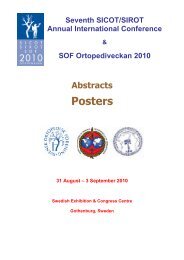sicotnews
sicotnews
sicotnews
Create successful ePaper yourself
Turn your PDF publications into a flip-book with our unique Google optimized e-Paper software.
Country to Country Series<br />
4 SICOTNEWS | February 2010 - No. 121<br />
Switzerland<br />
Prof Dr Pierre Hoffmeyer<br />
Professor of Orthopaedics<br />
Chairman of the Department of Orthopaedics, University Hospital of Geneva<br />
President, Swiss Orthopaedic Society<br />
SICOT National Delegate of Switzerland<br />
Switzerland lies in the centre of Europe and shares boundaries<br />
with France, Italy, Liechtenstein, Austria and Germany. It covers<br />
a land area of 41,285 km² (or 15,940 square miles). It hosts<br />
many lakes, natural and dammed, the largest being Lake<br />
Geneva with its 584 km² surface. The time zone is Central<br />
Europe (GMT +1 hour). The capital is Bern which lies in the<br />
geographic centre of Switzerland.<br />
Population<br />
At the latest national census in 2008, the population was 7.6<br />
million, mainly concentrated in the more urbanised Cantons of<br />
Zurich, Bern, Vaud, Saint Gallen, Basel and Geneva.<br />
Climate<br />
Switzerland is in a transition zone. The west is influenced by<br />
the Atlantic Ocean, which brings wind and moisture. In the<br />
East the climate is more continental with lower temperatures<br />
and less precipitation. As a rule winters are mild on the plateau<br />
between -5° and +10°C. Summers can be warm, up to 30°C in<br />
some regions.<br />
Language<br />
There are four official languages: German (65% of the population)<br />
in the centre and the east, French (18% pop.) in the west and in<br />
the north, Italian in the south (10% pop.) and Romansh, a<br />
Rhaeto-Roman dialect, in parts in the South-east.<br />
History and government<br />
Switzerland, officially named Confoederatio Helvetica (CH),<br />
began its existence in 1291 as a league of cantons in the Holy<br />
Roman Empire. Fashioned around the nucleus of the three<br />
districts of Schwyz, Uri, and Unterwalden, the Swiss<br />
Confederation slowly added new cantons. The Federal<br />
Constitution of 1874 established a central government while<br />
giving large powers of control to each canton. Strict neutrality<br />
was the policy in both world wars. Geneva became the seat of<br />
the League of Nations in 1919 and later the European<br />
headquarters of the United Nations and of a large number of<br />
international organisations including the International Red<br />
Cross and the WHO. In 2002, Switzerland became the 190th<br />
member of the UN. Switzerland has a popularly elected<br />
bicameral legislature. The executive is composed of seven<br />
ministers elected by the legislature and the presidency, limited<br />
to one year, rotates among these seven.<br />
Lake of Brienz in summer<br />
Economy<br />
Switzerland has a highly successful market economy based<br />
on international trade and banking. Tourism adds significantly<br />
to the economy. Switzerland has a worldwide reputation for<br />
the high quality of its export manufactures, which include<br />
machinery, chemicals, watches, textiles, precision instruments,<br />
and diverse high-tech products.<br />
THE PRACTICE OF ORTHOPAEDICS IN SWITZERLAND<br />
The birth of the Swiss Orthopaedic and Traumatology<br />
Association<br />
The history of the Swiss society goes back a long way. The<br />
beginnings of Orthopaedics in Switzerland start with Jean-<br />
André Venel who opened the first dedicated Orthopaedic<br />
Hospital in 1780 in Orbe, not far from Lausanne. His aim was<br />
to take care of crippled children and Venel developed among<br />
other working tools a shoe “sabot de Venel” designed to<br />
straighten club feet. This pioneering institution evolved, from<br />
1876, into the Hospice Orthopédique de la Suisse Romande in<br />
Lausanne. Other institutions dedicated to Orthopaedics were<br />
created throughout the country, in 1883 the Schulthess Clinic<br />
and in 1912 the Balgrist Clinic, both in Zurich. In Geneva, the<br />
Hôpital Gourgas was built in 1884 and dedicated to osteoarticular<br />
tuberculosis. The Santa Anna Klinik in Luzern in 1930<br />
began to take care of orthopaedic patients. Some of these<br />
institutions and others evolved into University clinics and centres<br />
devoted to orthopaedic surgery and later traumatology.
















